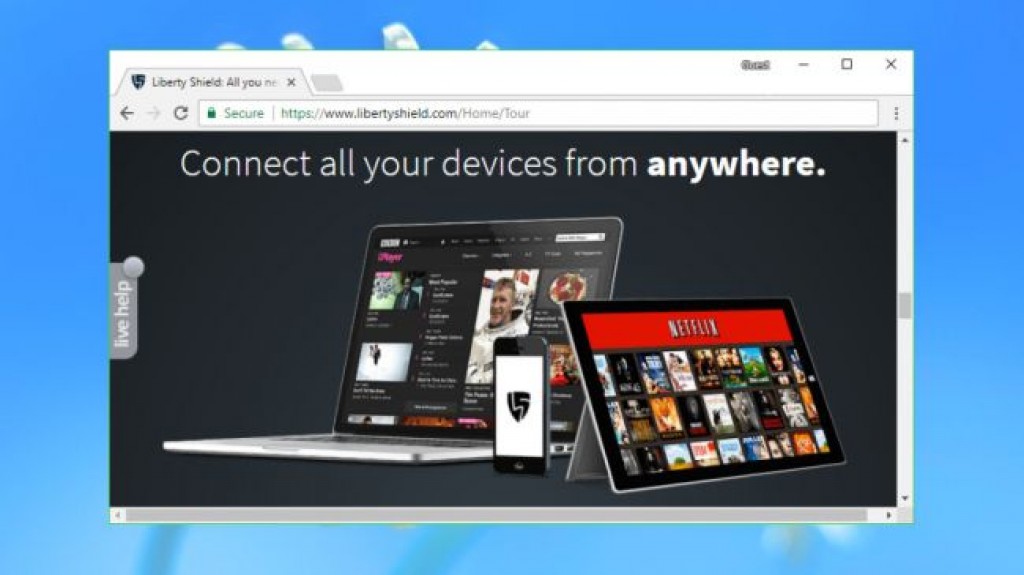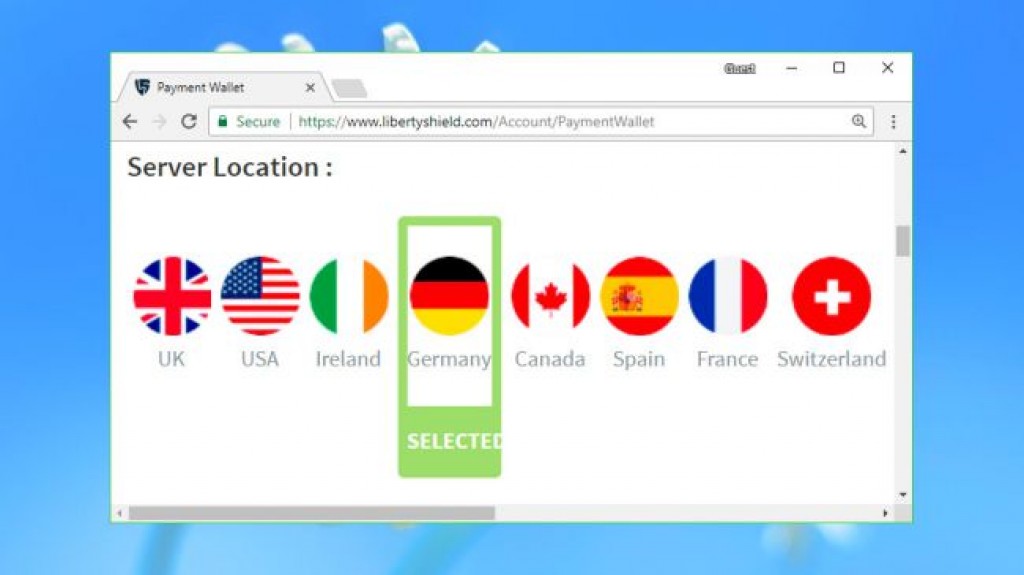
OUR VERDICT
Liberty Shield’s router package is easy-to-use and is backed by excellent UK-based support, but doesn’t have the power or configurability that experts might need.
FOR
- Low-priced router
- Excellent UK-based support
- Good UK speeds
- User-friendly
AGAINST
- Above average subscription prices
- Only eight locations
- No advanced router settings
- L2TP or PPTP only
Liberty Shield is a UK-based proxy and VPN provider, previously known as UK Proxy Server.
The company offers the usual range of software clients, along with a preconfigured router, both of which give you access to the same small network of eight locations: UK, US, Ireland, Germany, Canada, Spain, France and Switzerland.
The Liberty Shield website makes big claims about performance, claiming to offer “superfast Tier 2 network speed with sophisticated routing to help ensure zero buffering with video streaming.”
The website also suggests Liberty Shield can unblock Netflix amongst many other services that might be geo-blocked due to their location.
We’re interested in the router, a customized version of the popular MikroTik Hap ac lite box. This comes with five 10/100Mbps Ethernet ports, dual-chain 802.11b/g/n 2.4GHz Wi-Fi, single-chain 802.11ac 5GHz Wi-Fi, and a USB port for 3G/4G modems. There’s more detail on the MicroTik site if you need it.
The starting price is attractive at just £29.99 ($37.50) which includes your choice of power supply type (UK, EU, US), free UK shipping for the router and one month of VPN access.
Subscription prices are relatively high, though, ranging from £6.99 ($8.75) per month to an equivalent £5.83 ($7.30) for the annual plan. Liberty Shield’s VPN Router still seems reasonably cheap for the first year, but after that it begins to look relatively costly.
There’s some compensation in Liberty Shield’s comprehensive UK-based customer support. This is open from 9am to 9pm, 7 days a week, and includes live chat, email and support tickets, and even an option to schedule a call-back.
We tested the chat service and got a helpful and friendly response in less than a minute. It’s wise to be skeptical of web reviews, but reports on Trustpilot consistently praise Liberty Shield for its customer support.
Support really matters, too, especially with a VPN router where you might add new devices at any time. If you’re not the technical type, then spending £20 ($27) more a year to help solve these problems could seem like a good deal.

Privacy
The Liberty Shield website makes some apparently definitive statements about privacy, including: “We never share your data with anyone and don’t log your website usage through our servers in any form.”
There is some scope for session logging, as the official privacy policy goes on to explain:
“…we may collect the following information: times when connected to our service, choice of server location, and the total amount of data transferred per day…”
This is a little vague, and not ideal, but it’s also not unusual; many VPN providers do something similar.
We browsed the rest of the small print, too, but didn’t find anything unusual. It’s the usual stuff: don’t do anything illegal, don’t breach copyright, don’t be a spammer – you know the deal. The contracts all seemed relatively straightforward, with no sneaky clauses to catch you out.

Performance
The Liberty Shield VPN Router arrives in a surprisingly small box, yet it still contains everything you need: router, power supply, a very short Ethernet cable (around 0.25m), along with a tiny Quick Start guide and a card with an allocated login name and password.
The installation guide started off well. Plug one end of the router cable into the VPN box, the other into your regular router, plug in the power cable and wait for it to connect to the internet. Easy.
Unfortunately, the guide didn’t tell us what to do next. Should we look for an SSID and try to connect? Access the router from a browser? Do something else? There were no obvious clues.
After spending a few minutes exploring our options, we checked the web version of the support guide and spotted the problem. We weren’t missing anything, it was the fault of the printed setup guide, which somehow left out the most crucial line of all:
“To begin the activation process please visit https://www.libertyshield.com/activate and enter the SSID and Code from the front page of your booklet.”
That’s clumsy, but at least we solved the issue quickly. And even if we hadn’t, Liberty Shield’s excellent support is on hand to offer speedy solutions.
We headed off to the activation page, where a form asked us to enter the login credentials provided with the router. We also had to provide our name and email address to create a Liberty Shield account, and enter the details of the card that would be used for payment. (The first month is free, and if you cancel your subscription before the month is up, you won’t be charged anything at all.)
Moments after submitting the form, an email arrived reporting that our router was now activated and ready for use.
Sure enough, the SSID name of the Liberty Shield box was now visible, and we were able to connect to it from a laptop, tablet, phone and TV by entering our allocated wireless password.
By default, our router connected us to a UK VPN server. You can change this, but it takes a little work. There’s no local router console, so instead you must go to the Liberty Shield website, log in, choose your preferred location and connection method (VPN or Proxy), save the results, turn your router off, wait a couple of minutes, turn it on and wait for it to reconnect.
The web console offers a few other connection settings – protocol (PPTP by default, L2TP as an option), Wi-Fi SSID and password – but nothing like the power or configurability you’d get with a standalone router.
We started our performance tests* by using a wired connection, hopefully giving us a good idea of the best possible service speeds. Our router was initially set to use our nearest UK server, and this delivered solid results, with download speeds typically ranging from 52-58Mbps on a 75Mbps broadband connection. That’s not bad at all, especially as the website suggests the router has a maximum download speed of 30-40Mbps.
Switching to wireless connections showed no real difference on our Windows 10 laptop, which managed to max out its wireless adapter at around 44Mbps.
Our mobile saw a relatively dramatic drop in performance from around 50Mbps when connecting to our regular router, to more like 25Mbps when using Liberty Shield. That was unexpected, but as we couldn’t see why, and this isn’t an issue that affected other devices, we didn’t count it as a significant black mark against the product.
Switching our location to Germany saw speeds fall to around 20-30Mbps on a wired connection, around what we would expect from a regular VPN. UK-US connections were inconsistent and relatively disappointing, ranging anywhere from 6 to 20Mbps.
VPN routers don’t have the same data leak issues as software VPN clients because they’re not running on top of another device with its own network adapters and settings. We ran our regular privacy tests anyway, and sure enough they didn’t reveal anything to be concerned about.
We rounded off our checks by trying to visit a few geo-blocked sites, and found Liberty Shield accessed them without difficulty. There’s no guarantee that this situation will last, and sites like Netflix block new VPNs all the time, but at the time of writing, at least, the service works very well.
Final verdict
Liberty Shield VPN Router could work well for novice UK users who just want to plug in and go, but also need quality support to help them quickly fix any problems. This isn’t the ideal choice for experts, though, who may be put off by the small server network, lack of features and configurability, and above average subscription price.
Source: techradar.com









































